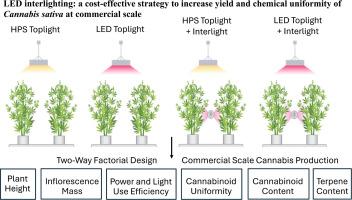LED interlighting: a cost-effective strategy to increase yield and chemical uniformity of Cannabis sativa at commercial scale
IF 4.2
2区 农林科学
Q1 HORTICULTURE
引用次数: 0
Abstract
Cannabinoid uniformity plays an important role in the quality and marketability of cannabis products. Light is an important environmental factor determining increased yield and improved secondary compound production, while energy consumption is a primary concern as lighting is one of the main input costs for controlled environment cannabis production systems. The objective of this study was to evaluate lighting strategies and compare these to commercial cultivation methods that maximize yield and uniformity of cannabinoids in cannabis plants. Four lighting treatments were investigated, including high pressure sodium (HPS) toplight, light-emitting diodes (LED) toplight, HPS toplight + interlight and LED toplight + interlight. Plants grown under HPS toplight displayed increased plant height. LED treatments significantly increased dry inflorescence mass compared to HPS treatments. The addition of interlighting increased biomass produced in the lower canopy, resulting in a significant increase in biomass produced per cannabis plant. When comparing light use efficiency (grams per mol), HPS toplight significantly increased inflorescence mass produced per mol of light received. However, analysis of power use efficiency expressed in grams per kilowatt-hour (kWh) revealed that LEDs provided increased yield at lower energy cost. LED toplight led to a 7 % improvement over HPS, with a 2 % increase in secondary metabolite production for Δ-9-tetrahydrocannabinol (THC) (p < 0.05). Interlighting did not significantly impact the lower canopy inflorescence THC values. LED treatments were more energy efficient at producing grams THC when analyzing THC power use efficiency. Cannabigerol concentrations significantly increased with LED treatments compared to HPS. Major terpenes showed no significant differences between treatments. This study has demonstrated the added benefit of implementing interlighting and LED toplighting in an indoor controlled environment cannabis production system. Importantly, LED toplight and interlight strategies show potential in competing with conventional HPS lighting strategies.

LED交叉照明:在商业规模上提高大麻产量和化学均匀性的成本效益策略
大麻素均匀性对大麻产品的质量和适销性起着重要作用。光是决定产量增加和二次化合物生产改善的重要环境因素,而能源消耗是主要关注的问题,因为照明是受控环境大麻生产系统的主要投入成本之一。本研究的目的是评估照明策略,并将其与商业种植方法进行比较,以最大限度地提高大麻植物中大麻素的产量和均匀性。研究了高压钠灯(HPS)、LED (LED)、高压钠灯+灯间和LED +灯间4种光照处理。在HPS环境下生长的植株株高增加。与HPS处理相比,LED处理显著增加了干花序质量。光照增加了下层冠层产生的生物量,导致每株大麻植物产生的生物量显著增加。当比较光利用效率(克/摩尔)时,HPS光照显著增加了每mol光照产生的花序数量。然而,以克每千瓦时(kWh)表示的电力使用效率分析显示,led以较低的能源成本提供了更高的产量。与HPS相比,LED光照改善了7%,Δ-9-tetrahydrocannabinol (THC)的次生代谢物产量增加了2% (p < 0.05)。光照对冠层下部花序THC值影响不显著。在分析四氢大麻酚电力使用效率时,LED处理在产生克四氢大麻酚方面更节能。与HPS相比,LED处理显著增加了大麻酚浓度。各处理间主要萜烯含量无显著差异。这项研究已经证明了在室内受控环境大麻生产系统中实施交叉照明和LED顶灯的额外好处。重要的是,LED顶灯和间灯策略显示出与传统HPS照明策略竞争的潜力。
本文章由计算机程序翻译,如有差异,请以英文原文为准。
求助全文
约1分钟内获得全文
求助全文
来源期刊

Scientia Horticulturae
农林科学-园艺
CiteScore
8.60
自引率
4.70%
发文量
796
审稿时长
47 days
期刊介绍:
Scientia Horticulturae is an international journal publishing research related to horticultural crops. Articles in the journal deal with open or protected production of vegetables, fruits, edible fungi and ornamentals under temperate, subtropical and tropical conditions. Papers in related areas (biochemistry, micropropagation, soil science, plant breeding, plant physiology, phytopathology, etc.) are considered, if they contain information of direct significance to horticulture. Papers on the technical aspects of horticulture (engineering, crop processing, storage, transport etc.) are accepted for publication only if they relate directly to the living product. In the case of plantation crops, those yielding a product that may be used fresh (e.g. tropical vegetables, citrus, bananas, and other fruits) will be considered, while those papers describing the processing of the product (e.g. rubber, tobacco, and quinine) will not. The scope of the journal includes all horticultural crops but does not include speciality crops such as, medicinal crops or forestry crops, such as bamboo. Basic molecular studies without any direct application in horticulture will not be considered for this journal.
 求助内容:
求助内容: 应助结果提醒方式:
应助结果提醒方式:


